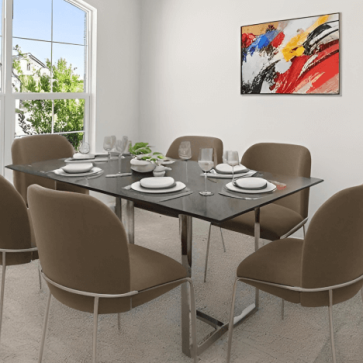If you thought home staging was on a one-way ticket to the top, think again. In 2017, 38% of real estate agents staged every single home they listed, confident that a well-dressed property was their best bet for a quick sale. Fast-forward to 2025, and that number has dropped to just 21%. It’s not that staging stopped working; it’s that the game has changed entirely.
After digging through eight years of National Association of REALTORS® Profile of Home Staging reports (2017-2025), we’ve uncovered some eye-opening trends that flip conventional wisdom on its head. From rising costs that are pricing out sellers to digital tools reshaping buyer expectations, the staging industry is at a crossroads.
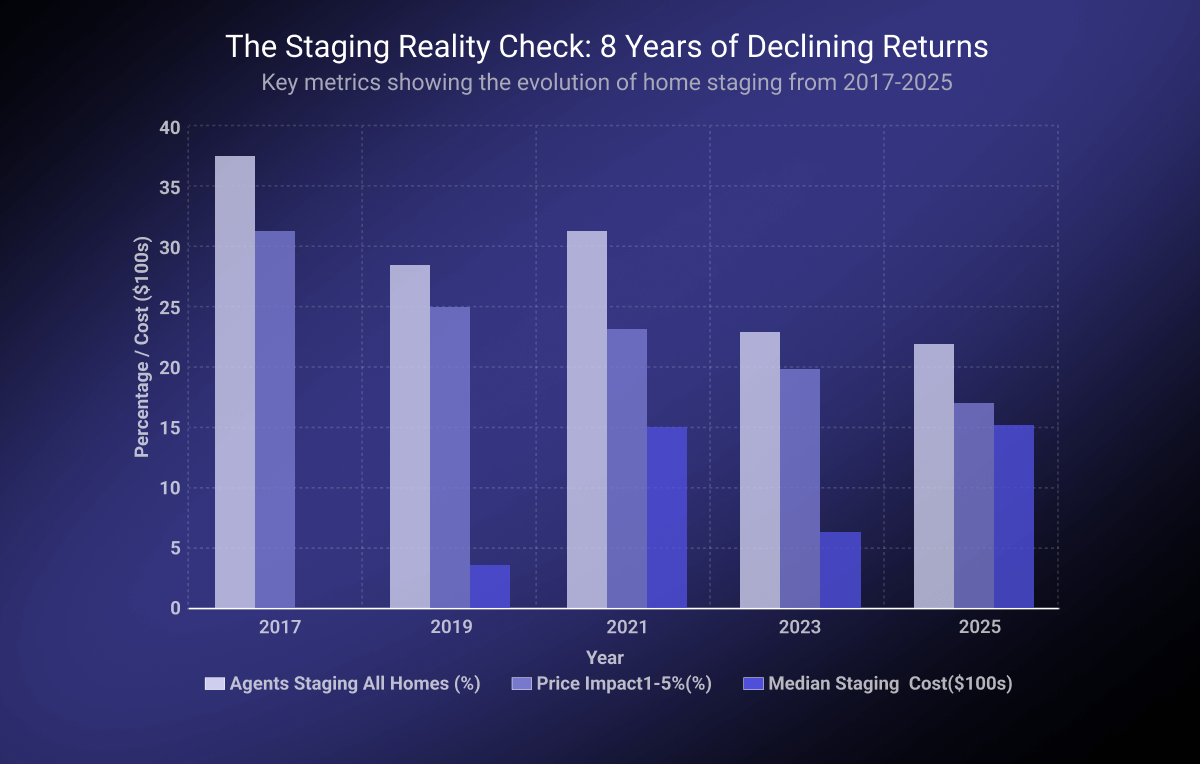 Numbers don’t lie, and they’re telling a story that might surprise you. First, home staging has gone from standard practice to selective strategy, with universal staging dropping nearly in half over eight years. Second, the financial returns are getting harder to justify: while 31% of agents reported 1-5% price increases from staging in 2017, only 17% see those same benefits today.
Third, professional home staging costs have skyrocketed from a median of $400 in 2019 to $1,500 in 2025, putting quality staging out of reach for many sellers. Finally, buyer behavior has shifted toward digital-first experiences, with virtual home viewing expectations doubling from 10 to 20 homes between 2021 and 2025.
These aren’t just minor market adjustments, they’re fundamental changes that signal staging’s evolution from a rising star to a mature, specialized service. The question isn’t whether staging still works (it does), but rather who gets left behind as the industry splits between high-end professional services and emerging alternatives.
Numbers don’t lie, and they’re telling a story that might surprise you. First, home staging has gone from standard practice to selective strategy, with universal staging dropping nearly in half over eight years. Second, the financial returns are getting harder to justify: while 31% of agents reported 1-5% price increases from staging in 2017, only 17% see those same benefits today.
Third, professional home staging costs have skyrocketed from a median of $400 in 2019 to $1,500 in 2025, putting quality staging out of reach for many sellers. Finally, buyer behavior has shifted toward digital-first experiences, with virtual home viewing expectations doubling from 10 to 20 homes between 2021 and 2025.
These aren’t just minor market adjustments, they’re fundamental changes that signal staging’s evolution from a rising star to a mature, specialized service. The question isn’t whether staging still works (it does), but rather who gets left behind as the industry splits between high-end professional services and emerging alternatives.
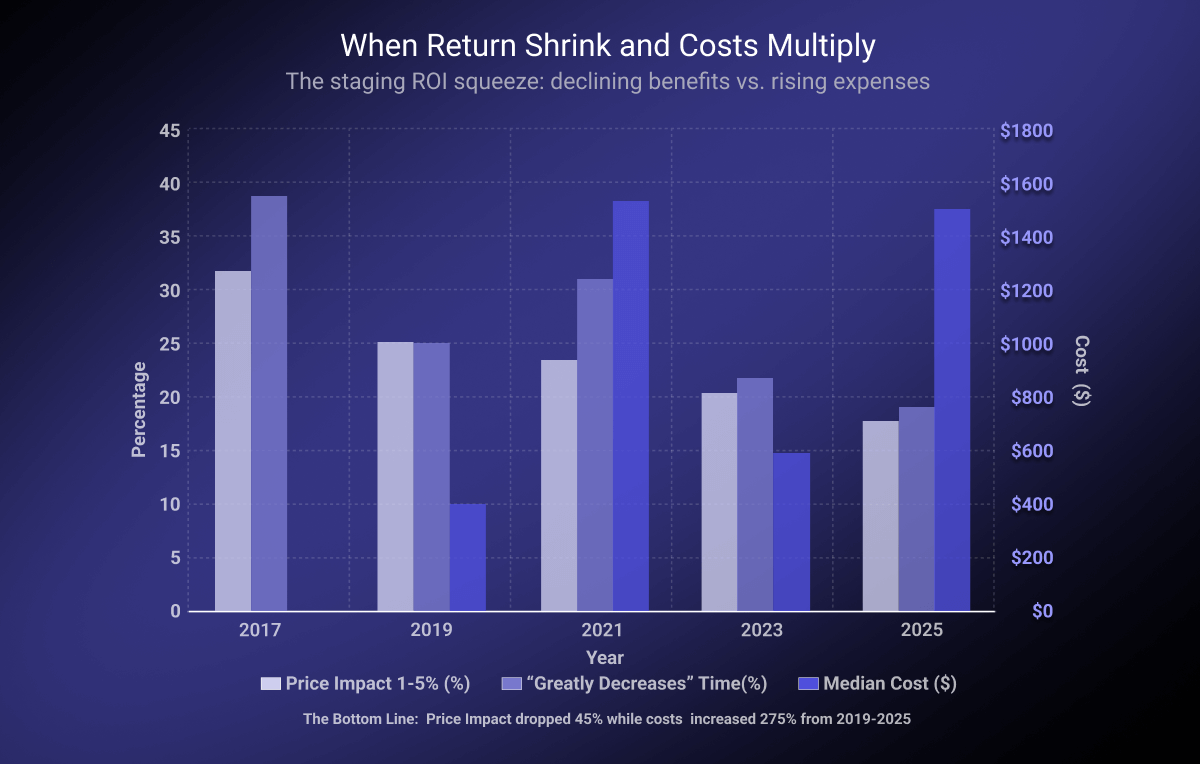 The harsh truth is that staging’s financial punch isn’t what it used to be. While agents in 2017 could count on nearly one-third of their staged homes fetching 1-5% higher offers, today only 17% see those same returns, a decline that should make any agent pause and ponder.
Even more telling, the percentage of agents reporting that staging “greatly decreases” time on the market has plummeted from 39% to just 19%. Meanwhile, the other side of the equation, costs, has moved in the opposite direction entirely. Professional staging that cost a manageable $400 in 2017 now commands a median price of $1,500, putting quality staging services out of reach for many middle-market sellers.
It’s simple math: when returns shrink and costs multiply, the value proposition starts to wobble. This isn’t to say staging has lost its magic entirely, but rather that its benefits have become more selective and situational. Smart agents are learning to read the tea leaves, identifying which properties and price points still deliver meaningful returns versus those where staging dollars might be better spent elsewhere.
The harsh truth is that staging’s financial punch isn’t what it used to be. While agents in 2017 could count on nearly one-third of their staged homes fetching 1-5% higher offers, today only 17% see those same returns, a decline that should make any agent pause and ponder.
Even more telling, the percentage of agents reporting that staging “greatly decreases” time on the market has plummeted from 39% to just 19%. Meanwhile, the other side of the equation, costs, has moved in the opposite direction entirely. Professional staging that cost a manageable $400 in 2017 now commands a median price of $1,500, putting quality staging services out of reach for many middle-market sellers.
It’s simple math: when returns shrink and costs multiply, the value proposition starts to wobble. This isn’t to say staging has lost its magic entirely, but rather that its benefits have become more selective and situational. Smart agents are learning to read the tea leaves, identifying which properties and price points still deliver meaningful returns versus those where staging dollars might be better spent elsewhere.
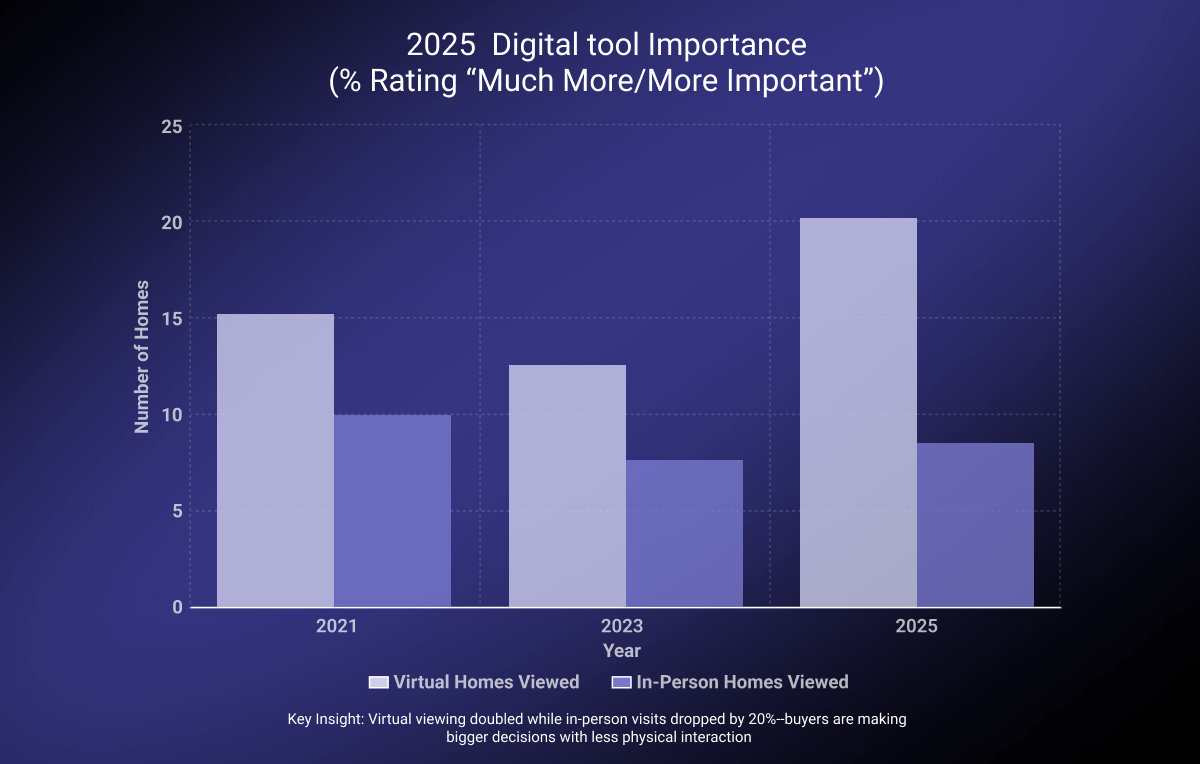 The pandemic didn’t just change how people buy homes; it rewired their comfort level with making major financial decisions based on digital presentations.
The numbers tell the story: virtual home viewing expectations doubled from 10 homes in 2021 to 20 homes by 2025, while in-person visits dropped to just 8 homes. This wasn’t a temporary blip; it was a permanent shift in buyer behavior that caught the industry off guard. Photos became the new front door, with 73% of buyers’ agents rating them as highly important, while traditional staging found itself competing for attention in an increasingly crowded digital landscape.
The irony is rich: just as physical staging costs were climbing out of reach for many sellers, buyers were becoming more comfortable making decisions based on what they saw on their screens rather than what they experienced in person. This digital-first mentality has created a fascinating paradox where the most expensive staging might never be seen by the majority of potential buyers, while a well-crafted online presentation can make or break a sale before anyone sets foot in the door.
The pandemic didn’t just change how people buy homes; it rewired their comfort level with making major financial decisions based on digital presentations.
The numbers tell the story: virtual home viewing expectations doubled from 10 homes in 2021 to 20 homes by 2025, while in-person visits dropped to just 8 homes. This wasn’t a temporary blip; it was a permanent shift in buyer behavior that caught the industry off guard. Photos became the new front door, with 73% of buyers’ agents rating them as highly important, while traditional staging found itself competing for attention in an increasingly crowded digital landscape.
The irony is rich: just as physical staging costs were climbing out of reach for many sellers, buyers were becoming more comfortable making decisions based on what they saw on their screens rather than what they experienced in person. This digital-first mentality has created a fascinating paradox where the most expensive staging might never be seen by the majority of potential buyers, while a well-crafted online presentation can make or break a sale before anyone sets foot in the door.
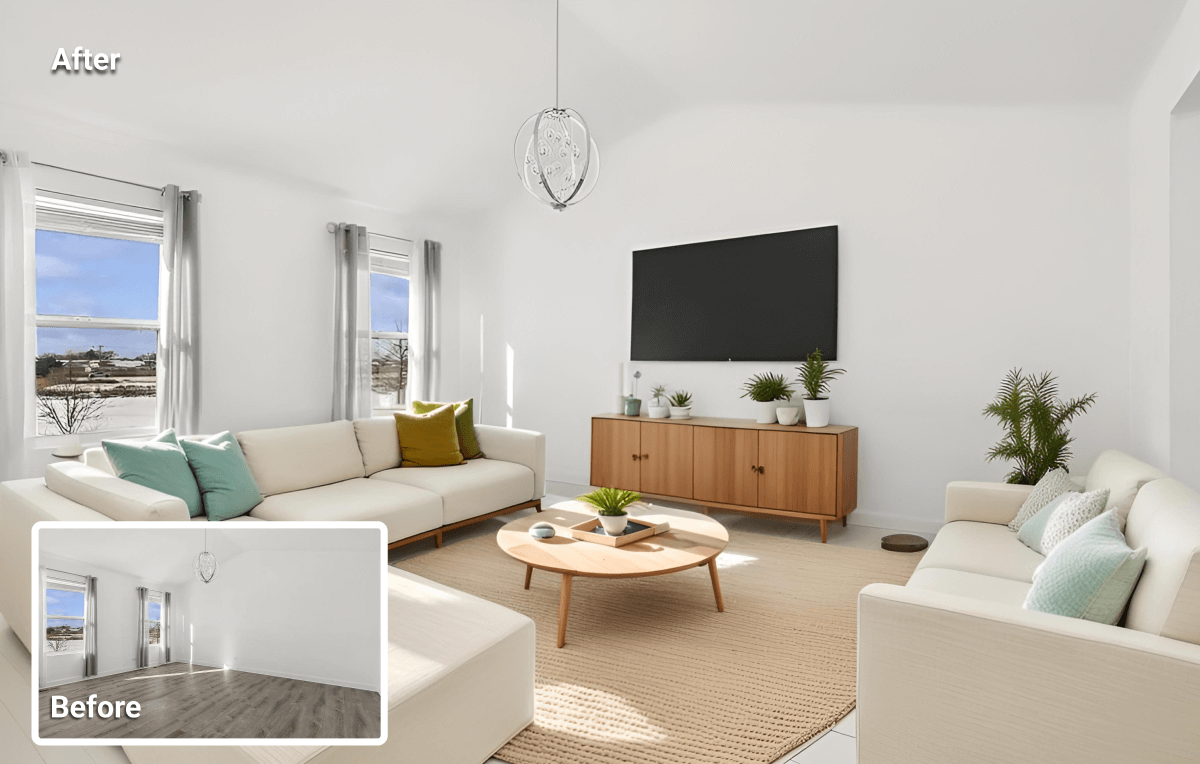 Let’s not sugarcoat it, virtual staging isn’t exactly setting the real estate world on fire. The numbers are what they are: only 16-18% of agents currently rate it as highly important, and more than one-third still consider it less valuable than traditional methods.
Virtual staging didn’t even appear on NAR’s radar until 2023, making it the new kid on the block in an industry that’s been perfecting physical staging for decades. The skepticism is real, and frankly, it’s understandable. Real estate professionals have built their reputations on tangible results, and virtual staging still feels like uncharted territory to many.
The technology exists, the tools are available, and the concept makes logical sense, but the industry adoption curve has been slower than molasses. Yet history teaches us that revolutionary ideas often face resistance before finding their moment. As Steve Jobs once said, “People don’t know what they want until you show it to them.” Sometimes the most transformative solutions need time to prove their worth, and the real estate industry, like most traditional sectors, doesn’t change overnight.
Let’s not sugarcoat it, virtual staging isn’t exactly setting the real estate world on fire. The numbers are what they are: only 16-18% of agents currently rate it as highly important, and more than one-third still consider it less valuable than traditional methods.
Virtual staging didn’t even appear on NAR’s radar until 2023, making it the new kid on the block in an industry that’s been perfecting physical staging for decades. The skepticism is real, and frankly, it’s understandable. Real estate professionals have built their reputations on tangible results, and virtual staging still feels like uncharted territory to many.
The technology exists, the tools are available, and the concept makes logical sense, but the industry adoption curve has been slower than molasses. Yet history teaches us that revolutionary ideas often face resistance before finding their moment. As Steve Jobs once said, “People don’t know what they want until you show it to them.” Sometimes the most transformative solutions need time to prove their worth, and the real estate industry, like most traditional sectors, doesn’t change overnight.
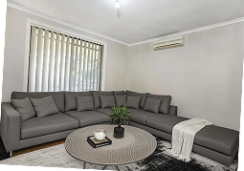
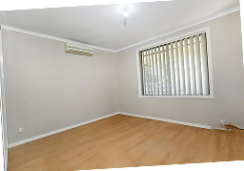
The Big Picture: Four Seismic Shifts That Changed Everything
 Numbers don’t lie, and they’re telling a story that might surprise you. First, home staging has gone from standard practice to selective strategy, with universal staging dropping nearly in half over eight years. Second, the financial returns are getting harder to justify: while 31% of agents reported 1-5% price increases from staging in 2017, only 17% see those same benefits today.
Third, professional home staging costs have skyrocketed from a median of $400 in 2019 to $1,500 in 2025, putting quality staging out of reach for many sellers. Finally, buyer behavior has shifted toward digital-first experiences, with virtual home viewing expectations doubling from 10 to 20 homes between 2021 and 2025.
These aren’t just minor market adjustments, they’re fundamental changes that signal staging’s evolution from a rising star to a mature, specialized service. The question isn’t whether staging still works (it does), but rather who gets left behind as the industry splits between high-end professional services and emerging alternatives.
Numbers don’t lie, and they’re telling a story that might surprise you. First, home staging has gone from standard practice to selective strategy, with universal staging dropping nearly in half over eight years. Second, the financial returns are getting harder to justify: while 31% of agents reported 1-5% price increases from staging in 2017, only 17% see those same benefits today.
Third, professional home staging costs have skyrocketed from a median of $400 in 2019 to $1,500 in 2025, putting quality staging out of reach for many sellers. Finally, buyer behavior has shifted toward digital-first experiences, with virtual home viewing expectations doubling from 10 to 20 homes between 2021 and 2025.
These aren’t just minor market adjustments, they’re fundamental changes that signal staging’s evolution from a rising star to a mature, specialized service. The question isn’t whether staging still works (it does), but rather who gets left behind as the industry splits between high-end professional services and emerging alternatives.
The Traditional Home Staging Reality Check: When “Standard Practice” Becomes Special Occasion
Current findings paint a clear picture: agents are becoming pickier about when and where they roll out the staging arsenal. This shift isn’t happening in a vacuum, it’s a calculated response to market realities that have turned staging from a no-brainer into a strategic decision. Back in 2017, more than one-third of agents treated staging like a standard checklist item, right alongside professional photography and curb appeal improvements. Today, that approach has become the exception rather than the rule. The 17-point drop in universal staging tells us that agents are asking harder questions: Which properties truly benefit? What’s the actual return? And perhaps most importantly, who’s footing the bill when home staging costs have nearly quadrupled? This trend reflects a maturing market where gut instinct has given way to data-driven decisions, and where the old “stage everything” mentality has been replaced by surgical precision in property preparation.The ROI Question: When the Numbers Stop Adding Up
 The harsh truth is that staging’s financial punch isn’t what it used to be. While agents in 2017 could count on nearly one-third of their staged homes fetching 1-5% higher offers, today only 17% see those same returns, a decline that should make any agent pause and ponder.
Even more telling, the percentage of agents reporting that staging “greatly decreases” time on the market has plummeted from 39% to just 19%. Meanwhile, the other side of the equation, costs, has moved in the opposite direction entirely. Professional staging that cost a manageable $400 in 2017 now commands a median price of $1,500, putting quality staging services out of reach for many middle-market sellers.
It’s simple math: when returns shrink and costs multiply, the value proposition starts to wobble. This isn’t to say staging has lost its magic entirely, but rather that its benefits have become more selective and situational. Smart agents are learning to read the tea leaves, identifying which properties and price points still deliver meaningful returns versus those where staging dollars might be better spent elsewhere.
The harsh truth is that staging’s financial punch isn’t what it used to be. While agents in 2017 could count on nearly one-third of their staged homes fetching 1-5% higher offers, today only 17% see those same returns, a decline that should make any agent pause and ponder.
Even more telling, the percentage of agents reporting that staging “greatly decreases” time on the market has plummeted from 39% to just 19%. Meanwhile, the other side of the equation, costs, has moved in the opposite direction entirely. Professional staging that cost a manageable $400 in 2017 now commands a median price of $1,500, putting quality staging services out of reach for many middle-market sellers.
It’s simple math: when returns shrink and costs multiply, the value proposition starts to wobble. This isn’t to say staging has lost its magic entirely, but rather that its benefits have become more selective and situational. Smart agents are learning to read the tea leaves, identifying which properties and price points still deliver meaningful returns versus those where staging dollars might be better spent elsewhere.
What this means: From standard practice to strategic investment
The writing is on the wall: staging has officially graduated from “nice-to-have” to “luxury service.” This shift represents more than just market fluctuations, it’s a fundamental restructuring of how the industry approaches property preparation. Agents are no longer asking “Should we stage?” but rather “Does this specific property, in this price range, in this market, justify the investment?” The days of blanket staging recommendations are fading fast, replaced by surgical precision in identifying homes where staging can still move the needle. High-end properties with sophisticated buyers? Absolutely worth the investment. Move-in ready homes in hot markets? Maybe not so much. This evolution has created two distinct camps: sellers who can afford premium home staging services and see meaningful returns, and everyone else who’s left wondering if there’s a middle ground. The gap between these two groups is widening, and it’s creating an opportunity for solutions that can serve the underserved majority without breaking the bank.The Digital Turn: When COVID-19 Rewrote the Playbook
 The pandemic didn’t just change how people buy homes; it rewired their comfort level with making major financial decisions based on digital presentations.
The numbers tell the story: virtual home viewing expectations doubled from 10 homes in 2021 to 20 homes by 2025, while in-person visits dropped to just 8 homes. This wasn’t a temporary blip; it was a permanent shift in buyer behavior that caught the industry off guard. Photos became the new front door, with 73% of buyers’ agents rating them as highly important, while traditional staging found itself competing for attention in an increasingly crowded digital landscape.
The irony is rich: just as physical staging costs were climbing out of reach for many sellers, buyers were becoming more comfortable making decisions based on what they saw on their screens rather than what they experienced in person. This digital-first mentality has created a fascinating paradox where the most expensive staging might never be seen by the majority of potential buyers, while a well-crafted online presentation can make or break a sale before anyone sets foot in the door.
The pandemic didn’t just change how people buy homes; it rewired their comfort level with making major financial decisions based on digital presentations.
The numbers tell the story: virtual home viewing expectations doubled from 10 homes in 2021 to 20 homes by 2025, while in-person visits dropped to just 8 homes. This wasn’t a temporary blip; it was a permanent shift in buyer behavior that caught the industry off guard. Photos became the new front door, with 73% of buyers’ agents rating them as highly important, while traditional staging found itself competing for attention in an increasingly crowded digital landscape.
The irony is rich: just as physical staging costs were climbing out of reach for many sellers, buyers were becoming more comfortable making decisions based on what they saw on their screens rather than what they experienced in person. This digital-first mentality has created a fascinating paradox where the most expensive staging might never be seen by the majority of potential buyers, while a well-crafted online presentation can make or break a sale before anyone sets foot in the door.
The Virtual Staging Opportunity: Reading Between the Lines
 Let’s not sugarcoat it, virtual staging isn’t exactly setting the real estate world on fire. The numbers are what they are: only 16-18% of agents currently rate it as highly important, and more than one-third still consider it less valuable than traditional methods.
Virtual staging didn’t even appear on NAR’s radar until 2023, making it the new kid on the block in an industry that’s been perfecting physical staging for decades. The skepticism is real, and frankly, it’s understandable. Real estate professionals have built their reputations on tangible results, and virtual staging still feels like uncharted territory to many.
The technology exists, the tools are available, and the concept makes logical sense, but the industry adoption curve has been slower than molasses. Yet history teaches us that revolutionary ideas often face resistance before finding their moment. As Steve Jobs once said, “People don’t know what they want until you show it to them.” Sometimes the most transformative solutions need time to prove their worth, and the real estate industry, like most traditional sectors, doesn’t change overnight.
Let’s not sugarcoat it, virtual staging isn’t exactly setting the real estate world on fire. The numbers are what they are: only 16-18% of agents currently rate it as highly important, and more than one-third still consider it less valuable than traditional methods.
Virtual staging didn’t even appear on NAR’s radar until 2023, making it the new kid on the block in an industry that’s been perfecting physical staging for decades. The skepticism is real, and frankly, it’s understandable. Real estate professionals have built their reputations on tangible results, and virtual staging still feels like uncharted territory to many.
The technology exists, the tools are available, and the concept makes logical sense, but the industry adoption curve has been slower than molasses. Yet history teaches us that revolutionary ideas often face resistance before finding their moment. As Steve Jobs once said, “People don’t know what they want until you show it to them.” Sometimes the most transformative solutions need time to prove their worth, and the real estate industry, like most traditional sectors, doesn’t change overnight.


Why the Timing May Be Right: Perfect Storm of Opportunity
Sometimes the stars align in ways that nobody sees coming, and virtual staging might be riding into just such a moment. Traditional staging costs have priced out huge swaths of sellers, agents are becoming selective about which properties get the full treatment, and buyers are making decisions based more on what they see online than what they experience in person. It’s a classic case of supply and demand getting out of whack, 77% of agents don’t stage all their homes, leaving a massive gap in the market for properties that could benefit from some form of visual enhancement but can’t justify a $1,500 investment. Meanwhile, buyer expectations for digital experiences have gone through the roof, with virtual viewing becoming the norm rather than the exception. Add to this mix the fact that photos now carry more weight than ever in the decision-making process, and you’ve got a market that’s practically begging for cost-effective visual solutions that can compete in the digital space without emptying sellers’ wallets.Strategic Positioning: Finding the Sweet Spot
The key to virtual home staging’s success isn’t trying to replace traditional staging, it’s about finding the right lane and staying in it. Think of it as the difference between a luxury sedan and a reliable pickup truck; both serve important purposes but for different situations and budgets. Virtual staging’s sweet spot lies in serving the forgotten middle: properties that need visual help but don’t warrant the full staging treatment. Picture a well-maintained ranch home priced at $350,000 that shows well but lacks personality, or a condo with great bones but dated furniture that’s throwing off potential buyers. These are the properties where a few dollars in virtual home staging could make the difference between lingering on the market and attracting serious offers.Buyer Behavior Evolution: When Family Dinners Include House Hunting
The modern home buyer doesn’t make decisions in isolation anymore, they’ve turned house hunting into a group activity that would make reality TV producers proud. Family consultation during the buying process has jumped from 30% to 40% between 2021 and 2025, meaning nearly half of all buyers are now running their decisions past relatives who won’t even live in the home. It’s like having a focus group for every property showing, and it’s changing how agents approach their presentations. Meanwhile, buyers’ perception of the home buying process has shifted toward realism, with 42% now expecting the journey to be difficult compared to just 35% in 2019. This isn’t pessimism; it’s buyers coming to the table better informed about market realities and competition levels.For real estate agents: The new staging playbook
The days of one-size-fits-all staging advice are officially over, and agents who haven’t updated their playbook are doing their clients a disservice. Smart agents are developing what we might call “staging triage”, quick assessment frameworks that help determine which properties deserve the full traditional staging treatment versus those that would benefit from alternative approaches. The most successful agents are becoming staging consultants rather than staging cheerleaders, helping sellers understand the true cost-benefit analysis rather than pushing expensive solutions that don’t fit the situation. They’re also getting comfortable with hybrid approaches, maybe staging the living room and master bedroom traditionally while using virtual staging for secondary spaces, or testing virtual concepts before committing to physical furniture.For sellers: Making smart staging decisions in a changing market
If you’re selling your home today, the staging decision tree looks nothing like it did five years ago. Today’s savvy sellers need to think like business owners: What’s my budget? What’s my timeline? What’s my competition doing? And most importantly—what does the data say about staging effectiveness in my specific price range and market? For sellers with homes priced above $500,000 in competitive markets, traditional home staging services might still deliver meaningful returns. But if you’re selling a starter home or downsizing property, throwing $1,500 at staging might eat into your profits without moving the needle on the sale price or timeline.For staging companies: Evolving or becoming extinct
The staging industry is at a fork in the road, and companies that don’t choose their path wisely risk becoming the Blockbuster of real estate services. The data is crystal clear: the market is splitting into two distinct segments, and trying to serve both with the same approach is a recipe for mediocrity. High-end staging companies should double down on their premium positioning and focus on luxury properties where $1,500-$3,000 investments make sense and clients value the white-glove experience. These companies need to become staging artists, not just furniture movers, offering custom design solutions that justify their premium pricing. On the flip side, there’s a massive opportunity for companies willing to serve the underserved middle market with innovative, cost-effective solutions. This might mean developing virtual staging divisions, offering “staging lite” packages with fewer rooms and shorter rental periods, or creating hybrid models that combine digital and physical elements. The companies that will thrive are those that pick a lane and own it completely.Looking Forward: What the Next Five Years Hold
If the past eight years taught us anything, it’s that the real estate industry moves like a glacier until it doesn’t, and then everything changes at once. Based on current trends, here’s what the staging landscape will likely look like by 2030. Traditional home staging will continue consolidating into a boutique service for high-end properties, with costs potentially hitting a median of $2,000-$3,000 for premium packages as companies focus on fewer, more profitable clients. Meanwhile, the technology gap will finally close as virtual staging tools become more sophisticated and widely accepted, particularly as artificial intelligence makes virtual room design faster and more realistic. The biggest shift will be the rise of DIY staging consultation services with agents and staging companies offering strategic guidance and room-by-room recommendations that sellers can implement themselves or with minimal professional help.The Bottom Line: Data Doesn’t Lie, But It Does Evolve
After eight years of tracking staging trends, one thing is abundantly clear: the industry that emerges from this transition will look nothing like the one we started with in 2017. Traditional staging isn’t disappearing, it’s finding its proper place in the luxury market where it belongs. Virtual staging isn’t the magic bullet some hoped for, but it’s also not the flash in the pan that skeptics predicted. The real winners will be the agents, sellers, and staging companies who stop trying to apply yesterday’s strategies to today’s market realities. The data tells us that staging still works, but only when it’s applied strategically rather than universally. Whether that means investing in high-end traditional staging, experimenting with virtual alternatives, or finding creative hybrid solutions depends entirely on your specific situation and market.FAQs
Always disclose virtual staging in listings and marketing materials, and consider hybrid approaches where key rooms are physically staged while secondary spaces use virtual enhancement.
Virtual staging tends to work best in open-concept spaces, well-lit rooms, and properties with good bones but dated furnishings, while challenging spaces like dark basements or awkward layouts benefit more from physical staging solutions.


